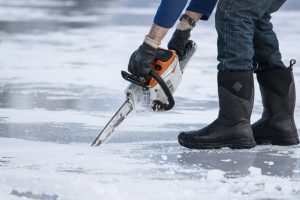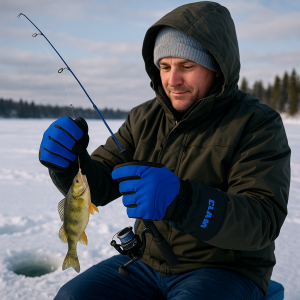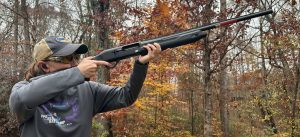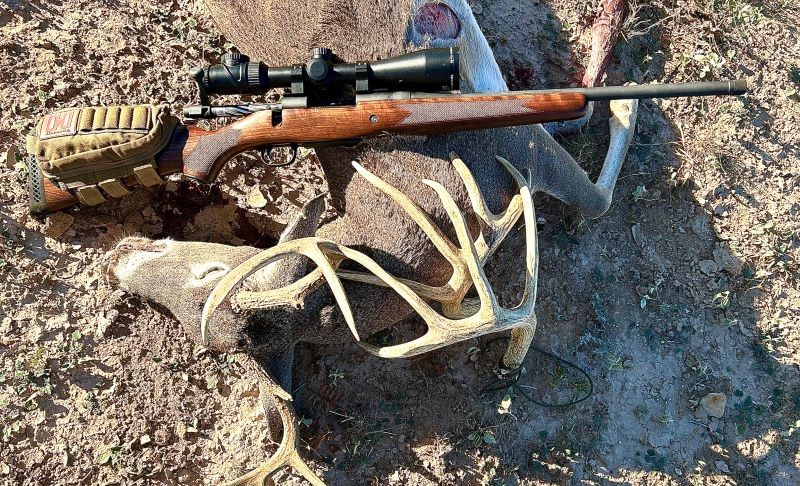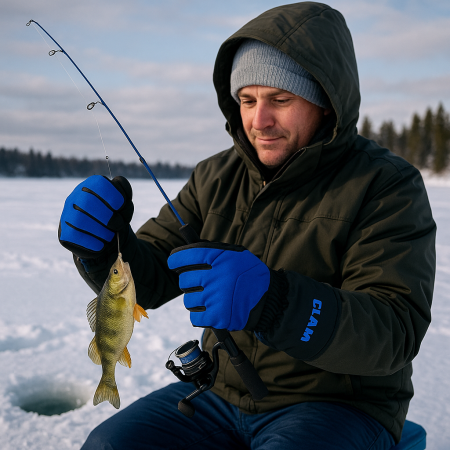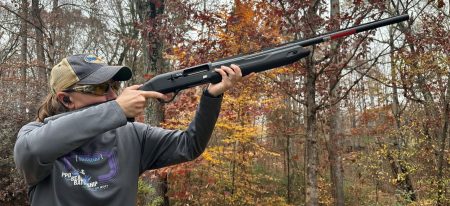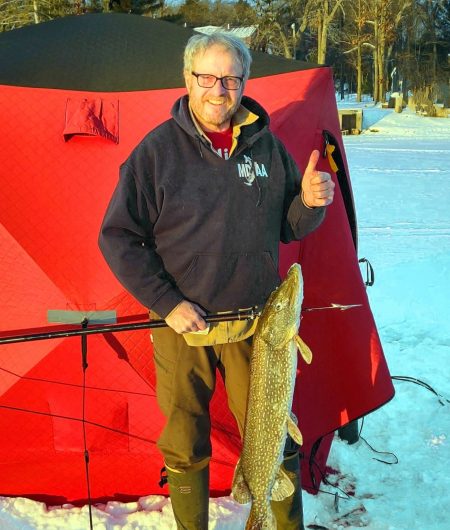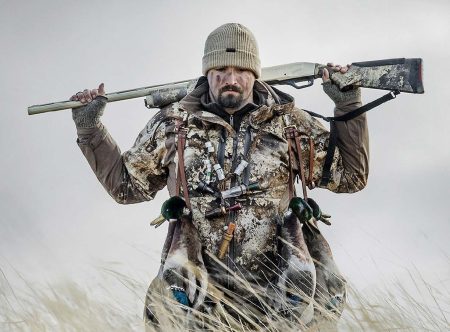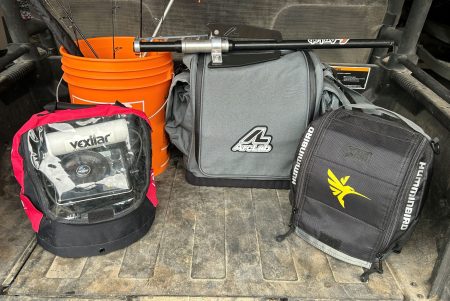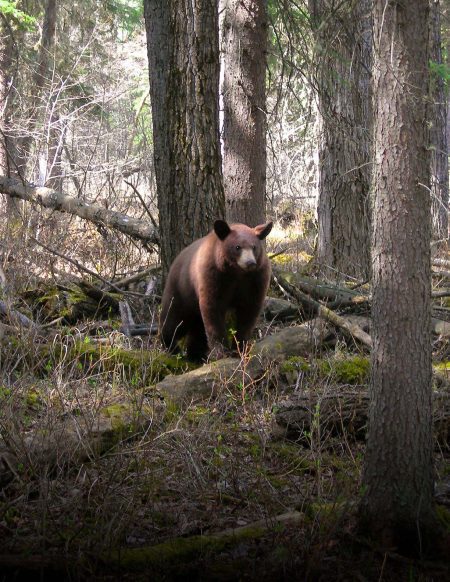At the turn of the 21st century, hunters in states like Iowa, Illinois, and Indiana were limited to shotguns, muzzleloaders, or bows when chasing whitetail deer. Straight-wall cartridges slowly entered the picture, changing the hunting landscape forever. Over time, rounds such as the .45-70 Government, .444 Marlin, and .450 Bushmaster proved their worth in deer camps, paving the way for new innovations. Among them, the new 400 Legend has quickly stood out as a game-changer. Combining modern ballistics with manageable recoil, this cartridge offers hunters a reliable option for ethical kills at ranges out to 250 yards. In this story,
What is the 400 Legend?
I’ll share my first-hand experiences with Mossberg’s Patriot rifle chambered in 400 Legend, how it compares to other popular straight-wall rounds, and why it’s shaping up to be one of the most exciting hunting cartridges available today. In time, things changed, and straight-wall rifle rounds were declared legal in state after state. Those such as the .45-70 Government, .444 Marlin, .375 Winchester (much like the older .38/55) and a few other handgun rounds like the .460 S&W Mag showed up in deer camps. Soon, rounds such as the .450 Bushmaster also started appearing in deer camps. Then, engineers at various gun and ammo companies got busy and designed such rounds as the .350 Legend, very much like the older .357 Maximum straight-wall round I occasionally shot in a Thompson Center Contender single-shot handgun; then the .360 Buckhammer, slightly faster and more energy than the .350 Legend; and more recently the .400 Legend.
Over the years, I had hunted a fair amount with a .45-70 and .375 Winchester and to a lesser extent with the .444 Marlin, mostly used on black bear, chambered in both a Marlin lever action and a T/C Encore handgun, but also occasionally on whitetails.
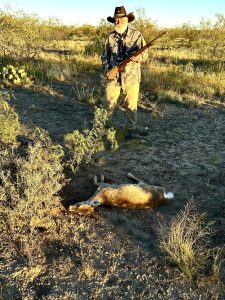
Enter Linda Powell with Mossberg. Linda and I go back to a time when she first got into the outdoor industry, when I took her on her first real whitetail deer hunt. Later, in spite of working with competing gun companies, we remained close friends. Then came a time when I decided to leave the gun company I was working with, a decision that was far from easy. A few days after doing so I called Linda if I could possibly get the use of a couple of Mossberg’s Patriot rifles to field-test. I really liked Mossberg’s “real wood” stocks, some of which are truly beautiful. I also loved the fact that Mossberg guns are made in my native Texas, near Eagle Pass.
The rifles she sent did not disappoint! I was greatly impressed with how they looked and especially how accurate they were with Hornady ammo! Since that time, I have shot and hunted with Mossberg Patriot rifles at every opportunity.
While on a black bear hunt in far northern Alberta, I sat down with Linda to do a weekly episode of my “DSC’s Campfires with Larry Weishuhn” podcast (available on Apple podcast, waypointtv.com, outdooraction.com, Spotify and many other places such as my YouTube Channel “Campfires with Larry Weishuhn, @campfireswithLarry, and my www.larryweishuhn.net website) and asked what she hunted black bear with more than anything else. She quickly responded, “I’ve hunted black bears many times throughout North America. It’s a passion with me. Of all the different calibers and rounds I’ve used, my current favorite is the .450 Bushmaster!”
Hmmm! As soon as I got home, I ordered a Mossberg Patriot .450 Bushmaster with a 20-inch barrel. Using Hornady’s 250-grain FTX loads and 245-grain Interlock SP American Whitetail, I headed to the range and was extremely pleased with how well the rifle shot both loads, accurate enough to precisely place a bullet into a deer, hog, or bear’s vitals out to 200+yards and beyond. I knew once I replaced the two-piece scope bases with an appropriate Picatinny rail and put a Stealth Vision scope complete with its optional operational lighted reticle on it, I just might have a perfect close-range hunting rifle. Lighted reticle because I know how difficult it is to see black crosshairs against a black bear’s coat, particularly in less-than-ideal light conditions when older boars finally make an appearance. I was happy and content with my combination!
Then I got a call from Linda Powell asking how I liked my 450 Bushmaster. I told her I planned on using it on whitetails here in Texas and then on black bear, spring and fall. Said she, “Larry have you considered hunting with a .400 Legend? We’ve got a Patriot with a 20-inch barrel, the muzzle threaded for a muzzlebrake or a suppressor. It’s a fairly new round and I think you might like it!” I seriously thought about saying, “No, I’m going to stick with the .450 Bushmaster…” But those are not the words that came out of my mouth. ”I’ll try one, particularly if it has a prettier wood stock than my Patriot .450 Bushmaster.” I could almost hear Linda smiling; she knows I love pretty wooden stocks. “I’ll have one coming to your local gun shop. If you like how it looks, send us a check; if you don’t, simply send it back.” Sounded good to me!
400 Legend Ballistics and Performance
That afternoon I started doing research on the .400 Legend. I first checked the Hornady website to see what ammo might be available and learn more about the round. There, I quickly learned that Hornady does not load the .400 Legend. Hmmm… I called Hornady. “No, we don’t load for that cartridge. But that company that starts with a “W” does, and I think they are the only ones who do…”
After more research, I got in touch with a couple of local gun geeks. They told me the round had only been out a relatively short period of time, and there really is no older parent case from which it was developed. They told me the 215-grain Winchester Power Point load the .400 Legend has a muzzle velocity of 2250 feet per second and drops to 1270 feet per second at 300 yards. The PowerPoint bullet leaves the muzzle with 2416-foot pounds of energy and retains 770-foot pounds of energy at 300 yards. Sighted in just shy of 2 inches high at 100 yards, the bullet drops about 5 inches at 200 yards and a bit over 26 inches at 300 yards. They added that in terms of energy, the .400 Legend supposedly produces 100% more energy than a 12-gauge slug, at about 55% less recoil (16.20 foot pounds of recoil energy). When compared to the venerable, though still popular .30-30 Winchester, the .400 Legend produces 20% more energy, and 25% more energy than its next of kin, the .350 Legend. Interesting…
What all this told me about the .400 Legend is, if accurate, it was a good deer round out to about 250 yards. After that, it quickly loses velocity and down-range energy. I would agree, and my personal opinion is based on hunting for many years with a great variety of rifle and handgun rounds and doing complete necropsies on all animals taken.
The rifle arrived at Schubert’s, where I live in Texas. Before doing the required paperwork, I asked Charles Schubert, the owner, to let me look at the rifle. He said, “I looked at it when it came in. Nice wood, fairly straight-grained but really nice.” At that point, I asked to fill out the paperwork. If Charles Schubert said it was pretty wood, that was good enough for me! And indeed, it was “good wood”, comparable to several of my other Mossberg Patriots. Nice! Finding ammo for the .400 Legend proved a bit of a chore. After not being able to find it in Texas, I finally found three boxes of Winchester PowerPoint in southwestern Louisiana.
Back from Louisiana, my intention was to mount a Stealth Vision SVT 3-18×44 scope on the .400 Legend. Unfortunately, I could not find a base that fit the rings I had on my 34mm tube scope. Nor could I find a Picatinny rail to fit the Mossberg’s short action. A couple of gun shops told me they could order me one, but I needed to get a scope on the rifle as soon as possible and could not wait for an ordered base to arrive. Back home I mounted one of my older Trijicon Accu-Point 4-16×50 scopes on my new Mossberg Patriot. Later that afternoon, I began sighting in at 100 yards. From a reasonable rest, I consistently put shots into a 2 ½-inch group. Turning to 200 yards, the groups held well, making the combination a solid 200-yard hunting rifle. Meaning that 200-yard shots would be somewhere within a 5-inch circle, well within a deer’s 8-inch wide vitals.
The following morning, my brother Glenn and I headed to my lease in western Texas, where I knew bucks would be “coming to horns”. We got there in time to hunt that afternoon. I hoped to mostly rattle and move. No sooner had we driven onto the property than an older buck that should have been an 8-point, but had less than 1 inch long brow tines, walked across the pasture road. One of my goals for the hunt was to take at least one older management buck. The property is managed under the Texas’ Managed Land Deer Permit program. My deer quota on the lease was five bucks, and nine does. I am allowed a big 8 or 9-point and one I choose to take as a “trophy.” Other bucks need to be management bucks, including those with 8 points or less, especially those without browntines.
Glenn and I drove around the corner after seeing the older buck walk across the road. We stopped and headed into the brush. I hoped to get ahead of the buck. A couple of hundreds into the brush I pointed to a small clump of mesquites for Glenn to stand by. I moved twenty steps to the east and immediately started rattling, after chambering a round in my Mossberg Patriot. I had hardly started rattling when a buck erupted out of the brush, ran right toward where Glenn was hidden, and nearly ran over him! A second buck burst out of the brush fifteen steps from me. It was the buck I had seen cross the road. As I brought the .400 Legend to my shoulder, I confirmed the buck was at least 6 years old, and he should have had 8 points but lacked brow tines. As the crosshairs came upon the buck’s shoulder, I pulled the trigger and watched the buck fall in his tracks.
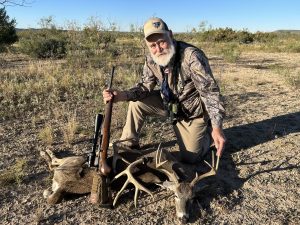
The .400 Legend did its job and did it quickly. Later, back at camp, I “took apart” the buck, saving the cape for Double Nickle Taxidermy, who does all my taxidermy. In doing so, I recovered the spent bullet on the opposite side, just under the skin on the opposite side from where it had entered the buck’s body, going through the onside shoulder, ribs, heart, lungs, backside ribs, and opposite shoulder. I was impressed!
Later, after Glenn had taken a buck, we started hunting for does. Walking in the part of the ranch that is scattered with mottes of juniper and mesquites, I spotted a doe 175 yards distant. She stood facing us but had no idea we were there. I moved forward about five steps and got a solid rest in the fork of a mesquite tree. When the crosshairs settled on the doe’s chest, I gently tugged the trigger. The doe pitched over backward and not so much as even kicked. Again, I was impressed with the .400 Legend.
The last days of December I asked my friend whose property I help manage for whitetail, David Cotton, if he would shoot a reasonably sized or big boar with my 400 Legend. His boar was shot squarely through the hog’s broadside vitals. The bullet traveled through thick skin, a tough cartilaginous shoulder shield, and a rib, punctured both lungs, broke another rib, but then was stopped by the cartilaginous shield on the opposite side. This is at 50 yards. The boar ran thirty steps and died.
My experience with the .400 Legend… Thus far, it has killed rather quickly the three animals that have been shot with my Mossberg Patriot. The rifle looks good, and the round kills quickly and humanely, which is a pretty good combination. I suspect my groups will become tighter once the barrel has been properly seasoned, which usually takes about 50 or so rounds. The barrel, too, might prefer another bullet and load. There are other Winchester loads, specifically the 190-grain Deer Season XP, and the 300-grain Super Suppressed. With either of these two other bullets and loads, the rifle might have been more accurate. However, the only ammo I could find was the 215-grain PowerPoint at that time.
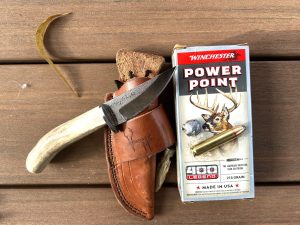
How will it perform on a black bear? Hopefully there will a spring bear hunt in its future. If I were planning on hunting in a State where a straight-wall cartridge is legal and required, it would certainly be one I would seriously consider using, particularly after trying at least one or more different bullets and loads (but only because of greater accuracy, not because of the killing factor). The always constants for me are Mossberg’s excellent hunter-accurate rifles and their pretty wood stocks. Love ‘em!
400 Legend vs. Other Straight-Wall Cartridges
Here we compare many of the other popular straight-walled cartridges.
FAQ: 400 Legend Cartridge
Is the 400 Legend good for deer hunting?
Yes, the 400 Legend is highly effective for whitetail deer. With strong energy retention out to 250 yards and manageable recoil, it offers ethical and reliable performance in straight-wall states.
What ammo is available for the 400 Legend?
Currently, Winchester offers multiple loads, including the 215-grain Power Point, 190-grain Deer Season XP, and 300-grain Super Suppressed. Ammo availability is improving but can still be limited in some regions.
400 Legend vs 350 Legend — which is better?
The 400 Legend delivers about 25% more energy than the 350 Legend, making it a stronger choice for bigger game. However, the 350 Legend may offer slightly less recoil and wider ammo availability.
Is the 400 Legend suitable for black bear or hog hunting?
Yes, the 400 Legend has proven effective on both hogs and black bears in field tests, delivering deep penetration and quick, humane kills within its effective range.
How far can you shoot with a 400 Legend?
The 400 Legend is best suited for shots within 200–250 yards. Beyond that, velocity and energy drop significantly, making it less ideal for long-range hunting.
Per our affiliate disclosure, we may earn revenue from the products available on this page. To learn more about how we test gear, click here.

